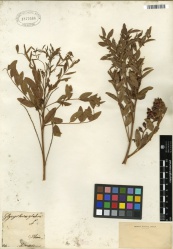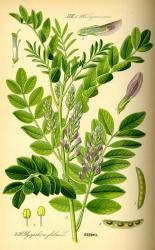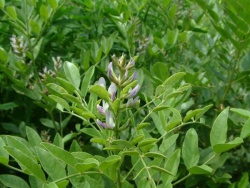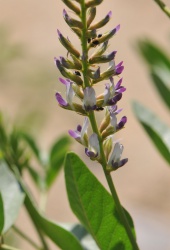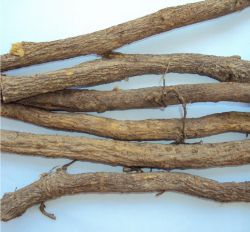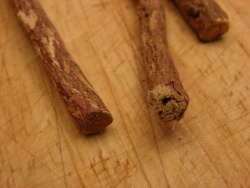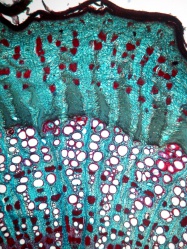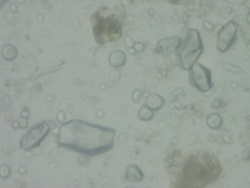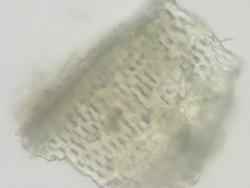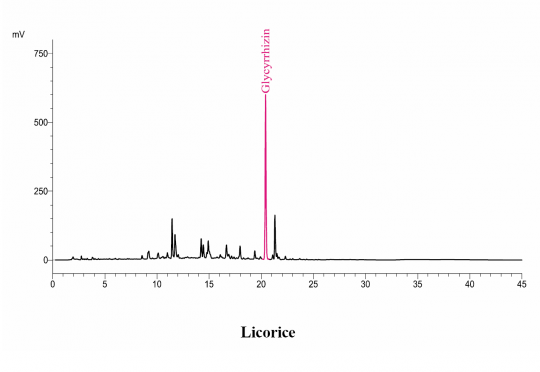Glycyrrhiza glabra (root)
| Line 84: | Line 84: | ||
|} | |} | ||
|} | |} | ||
| + | =High Performance Liquid Chromatographic Identification= | ||
| + | {{Botanical | source=Natural Remedies Pvt Ltd | ||
| + | | companyURL=http://www.naturalremedy.com/ | ||
| + | | companyimage=Natural Remedies Logo.png | ||
| + | |mainimage=G. glabra - ref standard p 97 - Quality Assessment of Selected IndianMedicinal Plants.png | ||
| + | |caption1=''G. glabra'' reference standard | ||
| + | | | ||
| + | | description='''Sample Preparations:''' Extract 1.0 g of coarsely powdered Glycyrrhiza root in 50 mL of water by boiling for about 5 minutes, and filter. Repeat for 4-5 times or until the extract is colorless. Combine the extracts, concentrate to about 100 mL, and cool to room temperature. Before injection, filter through a membrane filter of 0.45-um or finer pore size, discarding the first 5 mL of the filtrate. | ||
| + | |||
| + | '''Column:''' C18, 25-cm x 4.6 mm, 5-um, XXXXX, XXXXX | ||
| + | |||
| + | '''Mobile Phase:''' 0.14 g of anhydrous potassium dihydrogen phosphate in 900 mL of water, add 0.5 mL phosphoric acid, mix, complete to volume with water, and mix (Solution A); and acetonitrile (Solution B) | ||
| + | |||
| + | '''Elution:''' gradient program, see below | ||
| + | |||
| + | '''Flow rate:''' 1.5 mL/min | ||
| + | |||
| + | '''Detection:''' UV, 254 nm | ||
| + | |||
| + | '''Injection volume:''' 20 uL}} | ||
| + | |||
=High Performance Thin Layer Chromatographic Identification= | =High Performance Thin Layer Chromatographic Identification= | ||
Revision as of 20:49, 27 February 2014
Contents |
Nomenclature
Botanical Voucher Specimen
|
|
Organoleptic Characteristics
|
Macroscopic Characteristics
|
Microscopic Characteristics
|
High Performance Liquid Chromatographic Identification
'Sample Preparations: Extract 1.0 g of coarsely powdered Glycyrrhiza root in 50 mL of water by boiling for about 5 minutes, and filter. Repeat for 4-5 times or until the extract is colorless. Combine the extracts, concentrate to about 100 mL, and cool to room temperature. Before injection, filter through a membrane filter of 0.45-um or finer pore size, discarding the first 5 mL of the filtrate.
Column: C18, 25-cm x 4.6 mm, 5-um, XXXXX, XXXXX
Mobile Phase: 0.14 g of anhydrous potassium dihydrogen phosphate in 900 mL of water, add 0.5 mL phosphoric acid, mix, complete to volume with water, and mix (Solution A); and acetonitrile (Solution B)
Elution: gradient program, see below
Flow rate: 1.5 mL/min
Detection: UV, 254 nm
Injection volume: 20 uL
Source: Natural Remedies Pvt Ltd [14]
High Performance Thin Layer Chromatographic Identification
Supplementary Information
Sources
- ↑ Tropicos.org. Missouri Botanical Garden. 27 Feb 2014 <http://www.tropicos.org/Image/100253567>
- ↑ Natural Remedies Pvt Ltd http://www.naturalremedy.com/
- ↑ American Herbal Products Association. March 2013. Organoleptic Analysis of Herbal Ingredients. AHPA: Silver Spring, MD http://www.ahpa.org/
- ↑ Natural Remedies Pvt Ltd http://www.naturalremedy.com/
- ↑ Flora von Deutschland, Österreich und der Schweiz- Otto Wilhelm Thomé (1885)
- ↑ Encyclopedia of Life http://eol.org/data_objects/2447928
- ↑ Encyclopedia of Life http://eol.org/data_objects/24932881
- ↑ Natural Remedies Pvt Ltd http://www.naturalremedy.com/
- ↑ Encyclopedia of Life http://eol.org/data_objects/19163752
- ↑ Natural Remedies Pvt Ltd http://www.naturalremedy.com/
- ↑ Natural Remedies Pvt Ltd http://www.naturalremedy.com/
- ↑ Natural Remedies Pvt Ltd http://www.naturalremedy.com/
- ↑ Natural Remedies Pvt Ltd http://www.naturalremedy.com/
- ↑ Natural Remedies Pvt Ltd http://www.naturalremedy.com/
